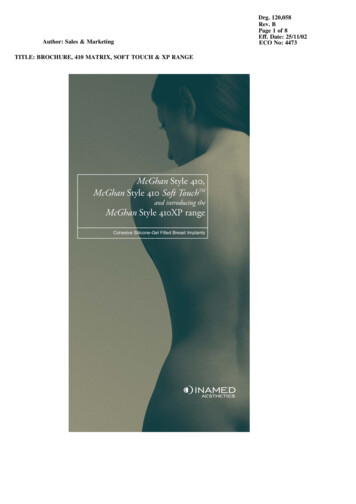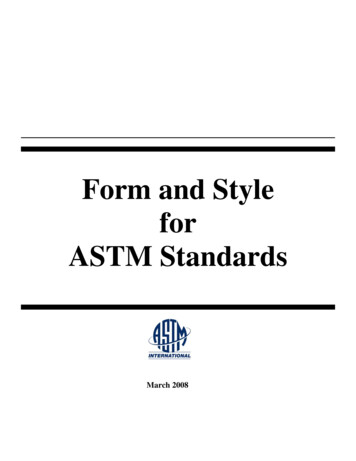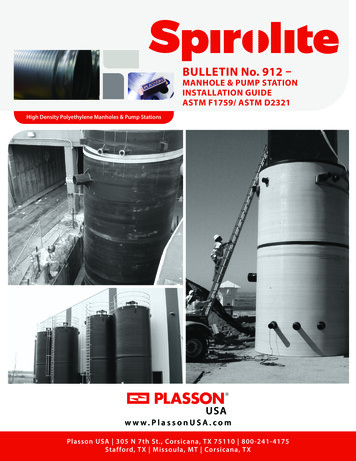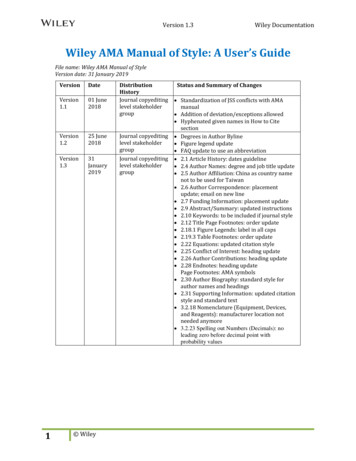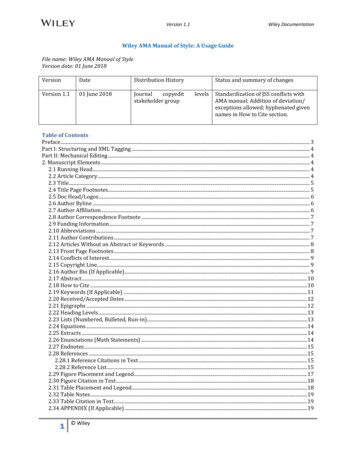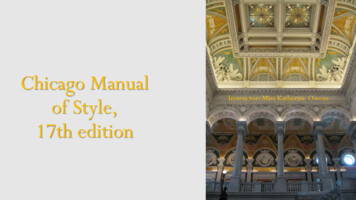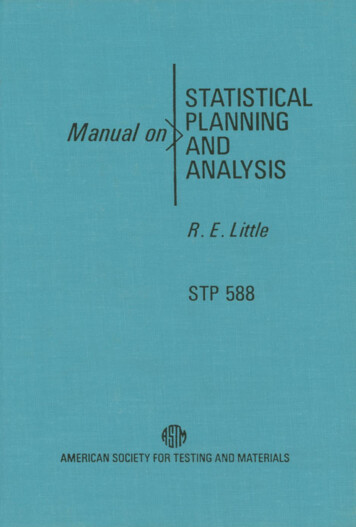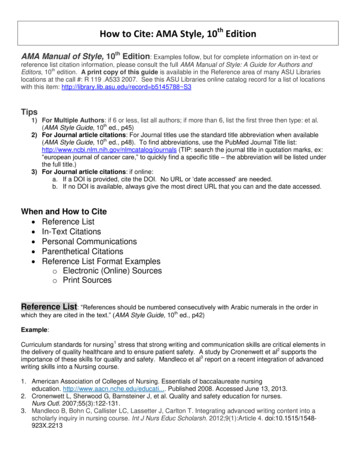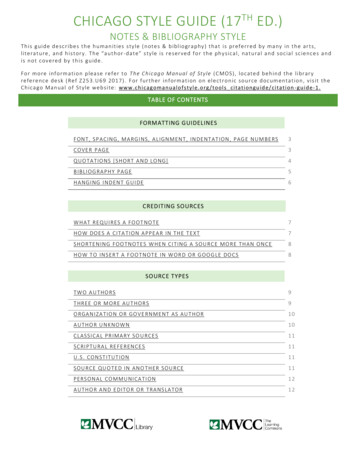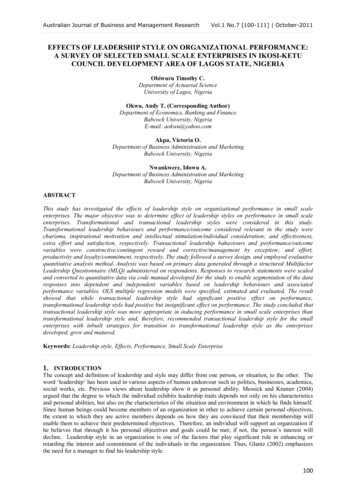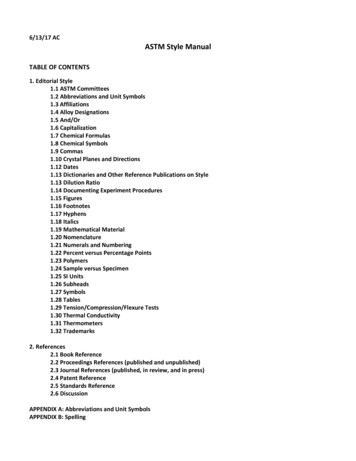
Transcription
6/13/17 ACASTM Style ManualTABLE OF CONTENTS1. Editorial Style1.1 ASTM Committees1.2 Abbreviations and Unit Symbols1.3 Affiliations1.4 Alloy Designations1.5 And/Or1.6 Capitalization1.7 Chemical Formulas1.8 Chemical Symbols1.9 Commas1.10 Crystal Planes and Directions1.12 Dates1.13 Dictionaries and Other Reference Publications on Style1.13 Dilution Ratio1.14 Documenting Experiment Procedures1.15 Figures1.16 Footnotes1.17 Hyphens1.18 Italics1.19 Mathematical Material1.20 Nomenclature1.21 Numerals and Numbering1.22 Percent versus Percentage Points1.23 Polymers1.24 Sample versus Specimen1.25 SI Units1.26 Subheads1.27 Symbols1.28 Tables1.29 Tension/Compression/Flexure Tests1.30 Thermal Conductivity1.31 Thermometers1.32 Trademarks2. References2.1 Book Reference2.2 Proceedings References (published and unpublished)2.3 Journal References (published, in review, and in press)2.4 Patent Reference2.5 Standards Reference2.6 DiscussionAPPENDIX A: Abbreviations and Unit SymbolsAPPENDIX B: Spelling
1. EDITORIAL STYLE1.1 ASTM CommitteesASTM committees should be cited as ASTM Committee D02 on Petroleum Products and Lubricants. Subsequentreferences can be cited as Committee D02. No space or dashes should be included. The format is D02, C17, etc.1.2 Abbreviations and Unit Symbols In the text, use unit symbols after numbers denoting a definite quantity. Example: "The tensile strength is45,000 psi (310 MPa)." Use unit symbols in tables and figures; in lists defining symbols used in equations;use unit symbols and abbreviations in the singular only. Thus "fifty kilograms" shall be designated "50 kg,"not "50 kgs." Exceptions: Figs., Nos., Eqs, Refs., Vols. When a long word or phrase for which there is no standard abbreviation is used frequently, it may bereplaced by an abbreviation that is explained when it first occurs. Examples: below top dead center (btdc),relative centrifugal force (rcf). Commonly accepted abbreviations for names of societies, associations, government agencies, etc., maybe used, provided the name is spelled out the first time it is used. Use no periods and run together.Examples: ASTM International, TAPPI, NASA, ARPA. The standard unit symbols and abbreviations for use in Society publications in Appendix A are so commonthat they may be used without explanation. For proper form and style for SI units see IEEE/ASTM SI-10Standard for Use of the International System of Units (SI): The Modern Metric System.1.3 AffiliationsUse superscript Arabic numerals to denote affiliations. Do not use professional titles, such as Director, Professor,Dean, Senior Scientist, etc. Do not include punctuation at the end of affiliations. Example:John Smith1 and Sarah Adams2,31Department of Mechanical Engineering, United States Naval Academy, 590 Holloway Rd., Annapolis, MD 214022CanmetMATERIALS, 183 Longwood Rd. South, Hamilton, ON L8P 0A5, Canada3ASTM International, 100 Barr Harbor Dr., West Conshohocken, PA 194281.4 Alloy DesignationsUse the following for alloy designations:3135 steel2024-T4 aluminumTi-4Al–3V-MoTi-6Al-4V0.5Ti molybdenum alloy or molybdenum with 0.5 % titanium or0.5Ti alloy (where molybdenum is understood)ASTM and SAE have jointly developed a unified numbering system (UNS) for alloy identification (Practice E527).1.5 And/OrDo not use this expression. For example, when "A and/or B" is truly the case, write "A or B, or both." When "A, B,and/or C" is truly the case, write "A, B, or C, or combinations thereof."1.6 Capitalization Use capitals sparingly, but when in doubt, capitalize. Use initial cap:o For "committee" where used in a title, as "Committee A01" or "Committee on Publications."o When referring to volumes, figures, tables, etc. (Vol. 2, Fig. 2, Table 2). Use lowercase in lessdirect references such as: "This volume contains ¼" or "In the same figure is shown ¼".
oo In such expressions as: Test 1, Specimen A, Cement B, Type 1, Class C, Grade B, etc.For Society, Staff, and Headquarters when referring to ASTM International, its Staff, and itsHeadquarters.Capitalize trademarks. The initial cap becomes lowercase after the word is accepted into the language asgeneric. It is permissible to use all caps in directions such as: "Turn the machine to OFF position" or "Turnthe dial to TITRATE."In headings and titles, capitalize all nouns, pronouns, verbs, adjectives, adverbs, and all other words offive or more letters. Do not use initial caps on prepositions, abbreviations, or the phrase "et al.," or in theword "to" in the infinitive form of a verb.The following are now lowercase: babbitt, bunsen, cellophane, diesel, kraft, neoprene, nylon, Portlandcement, saran.Use lowercase everywhere else, as "The committee recommends ¼" This rule also applies to use of"symposium," etc.1.7 Chemical FormulasChemical formulas should be used freely in tables and figures (example: CaSO4·2H2O). In text in which chemicalformulas are mentioned infrequently, spell out the names. Where they are mentioned frequently, spell out thename in the first reference to it, followed by the formula in parentheses. The formula alone may be usedsubsequently. Do not use chemical formulas for organic or complex inorganic compounds. Always spell out theword "water" and the name of the elements (use lead, not Pb). Isotopes may be written as carbon-14 or as 14C.1.8 Chemical SymbolsSpell out chemical compounds the first time they appear in the text and include the symbol in parentheses, e.g.,hydrochloric acid (HCl); use only the symbol thereafter. Spell out individual chemical elements. In figures andtables, use symbols freely for compounds and elements.1.9 CommasUse serial commas in lists with three or more items: Test 1, Specimen A, Cement B, and Type 1.1.10 Crystal Planes and DirectionsUse the following symbols for crystallographic planes and directions:plane (111)family of planes {111}direction [111]family of directions 111 1.11 DatesWhen there is no date, spell out the month. Examples: Jan. 15, 1995, and January 1995.For journals, the “Published online” date will be the date articles are sent to First Look.1.12 Dictionaries and Other Reference Publications on StyleFor spelling, punctuation, capitalization, and foreign words, use Merriam-Webster's Collegiate Dictionary. Forwords that do not appear in that dictionary, use Webster's Third New International Dictionary. For otherinformation on style use Manual of Style, The University of Chicago Press.1.13 Dilution RatioUse the form "9 1" rather than "9:1" for dilution ratios. This means that the 1 part solute is to be mixed with the 9parts solvent. Specify whether volumes or weights are being used, for example, volume/volume, weight/volume,etc.
1.14 Documenting Experiment ProceduresWhen testing is performed to obtain supportive data for papers or articles, authors shall prepare a summary ofthe procedures, and where appropriate, options followed, such that readers can understand how the testing wasperformed. This may include a schematic or written summary of steps followed.1.15 FiguresFigures, whether line drawings, photographs, or graphs, should be used to demonstrate some point orobservation. It is the author's responsibility to provide original, reproducible figures of professional quality. Seehttp://art.cadmus.com/da/guidelines.jsp for more detailed information.In-text references should appear as “Fig. 2a”. In figure files and in figure captions, use “(a)”, “(b)”, etc., to noteparts of a figure.1.16 FootnotesFor footnotes in tables, use superscript lowercase, roman letters, beginning with a for each table. The footnotesshould appear below the table.For all other footnotes appearing in the text of the paper, use superscript numbers. The number scheme shouldpick up from the author affiliation footnotes. For example, if on the first page there are 2 author affiliationfootnotes (1 and 2), any footnotes on the following pages should pick up with number 3.Do not use footnotes in figure captions. Either cite a previous footnote or reference (for example, "see Footnote3," or "taken from Ref. [4]"), or write out the reference in the caption.STPs will contain a footnote on the first page of each chapter that includes the symposium name, date, andlocation. Example:3ASTM Symposium on Developing Consensus Standards for Measuring Chemical Emissions from SprayPolyurethane Foam (SPF) Insulation on May 15–19, 2016 in Hilton Head, SC.1.17 Hyphens Hyphenate compound adjectives, such as: "50-mm gage," "low-alloy steel," and "cold-drawn wire." Writeexpressions such as the following with the hyphen after the first word: "high- and low-temperature tests."Where numerals are involved, omit all but the last hyphen, as in "50, 100, and 150-mm specimens." Forthe sake of appearance, omit hyphens in such expressions as "3 % nickel alloy" or "3 C rise intemperature." Also do not hyphenate chemical compounds and the words "stainless steel" and "castiron." Do not hyphenate an adverb-adjective combination when the adverb ends with "ly." Spelled-out fractions used as nouns are not hyphenated (one third of the load); however, when used asadjectives, they are hyphenated (a one-third share).1.18 ItalicsItalicize: All symbols for physical quantities that can have a numerical value (quantity symbols). Chemistry—N (normal), M (molar), c (concentration). Do not italicize symbols for the elements (Fe, N, Na,etc.) Exception: italicize N for nitrogen when it is used to denote position, as in N-methylaniline. Italicize o,m, and p as ortho, meta, and para; for example, p-cresol. Italicize and abbreviate secondary and tertiaryas sec and tert; for example, tert-butyl alcohol. Italicize iso when used in isooctane. Titles—Italicize titles of books, including ASTM books, such as Annual Book of ASTM Standards and ASTMSTP 1439. Foreign Words—Use Merriam-Webster's Collegiate Dictionary as a guide to foreign words.
Transistor Type—Use n-p-n, p-n-p, n-type, etc.Do not italicize: Letters used to subdivide a categorical classification, such as Method A, Cement B, Class C, Grade D, TypeE, Sample F. Metallurgy—A1 point, Ar1, etc. Abbreviations—pH, sin, cos, tan, log, d (for derivative).1.19 Mathematical MaterialEquations—should be numbered throughout the text with the number appearing on the right of the equation. Allequations and mathematical material should be formatted in MathType. The format for a numbered equation is:(1)Lp Ct / Rwhere:S stress, psi or Pa,M bending moment, lbf·in. or N···m,c distance from neutral axis to outermost fiber, in. or m, andI second moment of area, in.4 or m4.Exp versus e—If the exponent is relatively short and on one line, without superscripts or subscripts, use e:e(a-b)cxIf it is relatively long or has superscripts or subscripts, use exp:exp[x2/2 - 1n(x/a)]Fractions—Use the solidus (diagonal line) in the text:1/4Use the built-up fraction (with a horizontal line) in an equation. If you use a built-up fraction on one side of anequation, use it on the other side:dp kz – fpdyb(2)Use parentheses liberally to clearly show the complete numerator or denominator. For example, does log a/bmean log (a/b) or (log a)/b? Use the parentheses to clarify. If you write a/b c but mean a/(b c), useparentheses.For in text callouts, use “Eq 1” or “Eqs 2 and 3 ” (no periods).1.20 NomenclaturePlace the nomenclature section at the beginning of the manuscript, after the keywords and before theIntroduction.1.21 Numerals and Numbering Use Arabic numbers throughout. Spell out the number for multiple-number expressions, e.g., fifteen 2-cmrods. Place a zero before a decimal point, e.g., 0.65. Use commas for numbers containing more than threedigits, e.g., 12,365. Spell out all numbers from one through twelve, with the following exceptions:o Use numerals when the quantity is partly fractional, as: 1.15, 1½.o Use numerals when followed by an expression having a standard unit symbol, as: 5 mm, 9 %. If for any reason the standard abbreviation or unit symbol of the expression following the number is notused, or if the expression does not admit of abbreviation (as year, ton, etc.), the use of numerals is
optional, unless covered in the following paragraphs:In statements containing two or more numbers, one of which is greater than twelve, express all numbersas numerals, such as "2 tests and 16 weighings."In a series of connected numerical statements implying precision, use numerals, as "5 months, 3 days."Use numerals after abbreviations, as: Vol 26, Fig. 2.Use numerals for all numbers exceeding twelve, with the following exceptions:o Do not begin a sentence with a numeral. When the numeral is spelled out, also spell out the unitfollowing, as "One gram is usually sufficient."o Spell out round numbers used in an indefinite sense, such as, "a hundred meters or so."1.22 Percent versus Percentage PointsWhen a quantity is reduced from 40 to 30, it is reduced by 25 %. When a quantity decreases from 40 % to 30 %, itdecreases by 10 percentage points. Use the forms "mass percent," "volume percent," "atom percent," etc.1.23 PolymersWhere the name of the monomer is one word, the prefix "poly" is simply run in, as: polystyrene, polyisobutylene,etc. Where the name of the monomer is two words, they are enclosed in parentheses and the prefix "poly"added, as in the following words: poly(vinyl chloride), poly(methyl methacrylate).1.24 Sample versus SpecimenIn general, the word "sample" should be used only to describe a piece or quantity of bulk material that has beenselected by some sampling process. Pieces or quantities taken from the sample for testing are called "specimens."Quantities of liquid or bulk aggregate are usually called "samples," because a sampling procedure is usually usedto obtain them.To describe the piece on which a test is made, use "specimen" or "test specimen," not "piece" or "sample."1.25 SI UnitsSI units shall be included in all ASTM publications in accordance with the latest edition of SI-10.1.26 SubheadsManuscripts should be orga
1.1 ASTM Committees ASTM committees should be cited as ASTM Committee D02 on Petroleum Products and Lubricants. Subsequent references can be cited as Committee D02. No space or dashes should be included. The format is D02, C17, etc. 1.2 Abbreviations and Unit Symbols In the text, use unit symbols after numbers denoting a definite quantity. Example: "The tensile strength is
